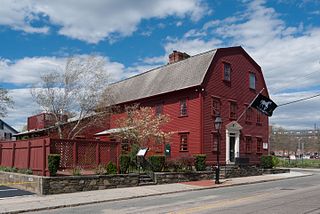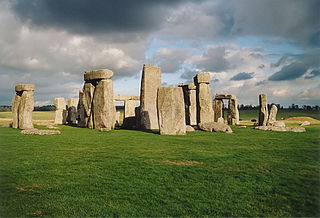
Roger Williams was a Puritan minister, theologian, and author who founded Providence Plantations, which became the Colony of Rhode Island and Providence Plantations and later the U.S. State of Rhode Island and Providence Plantations, now the State of Rhode Island. He was a staunch advocate for religious freedom, separation of church and state, and fair dealings with Native Americans.

Aquidneck Island, also known as Rhode Island, is an island in Narragansett Bay in the state of Rhode Island. The total land area is 97.9 km2 (37.8 sq mi), which makes it the largest island in the bay. The 2000 United States Census reported its population as 60,870.

The Colony of Rhode Island and Providence Plantations was one of the original Thirteen Colonies established on the east coast of America, bordering the Atlantic Ocean. It was founded by Roger Williams. It was an English colony from 1636 until 1707, and then a colony of Great Britain until the American Revolution in 1776, when it became the State of Rhode Island.

John Clarke was a physician, Baptist minister, co-founder of the Colony of Rhode Island and Providence Plantations, author of its influential charter, and a leading advocate of religious freedom in America.

Samuel Gorton (1593–1677) was an early settler and civic leader of the Colony of Rhode Island and Providence Plantations and President of the towns of Providence and Warwick. He had strong religious beliefs which differed from Puritan theology and was very outspoken, and he became the leader of a small sect of converts known as Gortonians, Gortonists or Gortonites. As a result, he was frequently in trouble with the civil and church authorities in the New England colonies.

William Coddington was an early magistrate of the Massachusetts Bay Colony and later of the Colony of Rhode Island and Providence Plantations. He served as the judge of Portsmouth and Newport, governor of Portsmouth and Newport, deputy governor of the four-town colony, and then governor of the entire colony. Coddington was born and raised in Lincolnshire, England. He accompanied the Winthrop Fleet on its voyage to New England in 1630, becoming an early leader in Boston. There he built the first brick house and became heavily involved in the local government as an assistant magistrate, treasurer, and deputy.

The history of Rhode Island is an overview of the Colony of Rhode Island and Providence Plantations and the state of Rhode Island from pre-colonial times to the present.

Benedict Arnold was president and then governor of the Colony of Rhode Island and Providence Plantations, serving for a total of 11 years in these roles. He was born and raised in the town of Ilchester, Somerset, England, likely attending school in Limington nearby. In 1635 at age 19, he accompanied his parents, siblings, and other family members on a voyage from England to New England where they first settled in Hingham in the Massachusetts Bay Colony. In less than a year, they moved to Providence Plantation at the head of the Narragansett Bay at the request of Roger Williams. In about 1638, they moved once again about five miles (8 km) south to the Pawtuxet River, settling on the north side at a place commonly called Pawtuxet. Here they had serious disputes with their neighbors, particularly Samuel Gorton, and they put themselves and their lands under the jurisdiction of Massachusetts, a situation which lasted for 16 years.
Nicholas Easton (c.1593–1675) was an early colonial President and Governor of Rhode Island. Born in Hampshire, England, he lived in the towns of Lymington and Romsey before immigrating to New England with his two sons in 1634. Once in the New World, he lived in the Massachusetts Bay Colony towns of Ipswich, Newbury, and Hampton. Easton supported the dissident ministers John Wheelwright and Anne Hutchinson during the Antinomian Controversy, and was disarmed in 1637, and then banished from the Massachusetts colony the following year. Along with many other Hutchinson supporters, he settled in Portsmouth on Aquidneck Island, later a part of the Colony of Rhode Island and Providence Plantations. He was in Portsmouth for about a year when he and eight others signed an agreement to create a plantation elsewhere on the island, establishing the town of Newport.

William Carpenter was a co-founder of Rhode Island and Providence Plantations, born about 1610, probably in Amesbury, Wiltshire, England. He died September 7, 1685 in the Pawtuxet section of Providence, now in Cranston, Rhode Island. He was listed by 1655 as a "freeman" of the colony.
John Greene Sr. was an early settler of the Colony of Rhode Island and Providence Plantations, one of the 12 original proprietors of Providence, and a co-founder of the town of Warwick in the colony, sailing from England with his family in 1635. He first settled in Salem in the Massachusetts Bay Colony, but he had difficulty with the Puritan authority and soon followed Roger Williams to Providence, becoming one of the original proprietors of that town. In 1643, he joined Samuel Gorton and ten others in purchasing land that became the town of Warwick. Difficulties with Massachusetts ensued, until he accompanied Gorton on a trip to England where they secured royal recognition of their town.

The Rhode Island Royal Charter provided royal recognition to the Colony of Rhode Island and Providence Plantations, approved by England's King Charles II in July 1663. It outlined many freedoms for the inhabitants of Rhode Island and was the guiding document of the colony's government over a period of 180 years.

Samuel Wilbore was one of the founding settlers of Portsmouth in the Colony of Rhode Island and Providence Plantations. He emigrated from Essex, England to Boston with his wife and three sons in 1633. He and his wife both joined the Boston church, but a theological controversy began to cause dissension in the church and community in 1636, and Wilbore aligned himself with John Wheelwright and Anne Hutchinson, signing a petition in support of dissident minister Wheelwright. In so doing, he and many others were disarmed and dismissed from the Boston church. In March 1638, he was one of 23 individuals who signed a compact to establish a new government, and this group purchased Aquidneck Island, then known as "Rhode Island", from the Narragansett Indians at the urging of Roger Williams, establishing the settlement of Portsmouth.
John Porter was an early colonist in New England and a signer of the Portsmouth Compact, establishing the first government in what became the Colony of Rhode Island and Providence Plantations. He joined the Roxbury church with his wife Margaret in 1633, but few other records are found of him while in the Massachusetts Bay Colony until he became involved with John Wheelwright and Anne Hutchinson during what is known as the Antinomian Controversy. He and many others were disarmed for signing a petition in support of Wheelwright and were compelled to leave the colony. Porter joined a group of more than 20 men in signing the Portsmouth Compact for a new government, and they settled on Rhode Island where they established the town of Portsmouth. Here Porter became very active in civic affairs, serving on numerous committees over a period of two decades and being elected for several terms as Assistant, Selectman, and Commissioner. He was named in Rhode Island's Royal Charter of 1663 as one of the ten Assistants to the Governor.
Randall Holden was an early inhabitant of the Colony of Rhode Island and Providence Plantations, one of the original founders of Portsmouth, and one of the co-founders of the town of Warwick. He came to New England from Salisbury, Wiltshire, England and is first recorded as one of the signers of the Portsmouth Compact. Following a few years on Aquidneck Island, he joined Samuel Gorton and ten others to establish the town of Warwick in early 1643 on land purchased from the Indian sachems.
William Dyer was an early settler of the Colony of Rhode Island and Providence Plantations, a founding settler of both Portsmouth and Newport, and Rhode Island's first Attorney General. He is best known for being the husband of the Quaker martyr, Mary Dyer, who was executed for her Quaker activism. Sailing from England as a young man with his wife, Dyer first settled in Boston in the Massachusetts Bay Colony, but like many members of the Boston church became a supporter of the dissident ministers John Wheelwright and Anne Hutchinson during the Antinomian Controversy, and signed a petition in support of Wheelwright. For doing this, he was disenfranchised and disarmed, and with many other supporters of Hutchinson, he signed the Portsmouth Compact, and settled on Aquidneck Island in the Narragansett Bay. Within a year of arriving there, he and others followed William Coddington to the south end of the island where they established the town of Newport.
Richard Smith (1596–1666) was the first European settler in the Narragansett country in the Colony of Rhode Island and Providence Plantations. He established a trading post on the western side of the Narragansett Bay at a place called Cocumscussoc which became the village of Wickford in modern-day North Kingstown, Rhode Island.
Samuel Wilbur Jr. was an early settler of Portsmouth in the Colony of Rhode Island and Providence Plantations, and one of seven original purchasers of the Pettaquamscutt lands which would later become South Kingstown, Rhode Island. His father, Samuel Wilbore, had been an early settler in Boston who was dismissed from the Massachusetts Bay Colony for supporting the dissident ministers Anne Hutchinson and John Wheelwright, becoming one of the signers of the compact that established the town of Portsmouth. The subject Samuel was willed his father's Rhode Island lands, and appears to have lived in Portsmouth most of his life. He married Hannah Porter, the daughter of another signer of the Portsmouth Compact, John Porter. Beginning in 1656 Wilbur held a number of important positions within the colony, including Commissioner, Deputy to the General Assembly, Assistant to the Governor, and Captain in a Troop of Horse. He wrote his will in August 1678, though it was not probated until more than three decades later. Wilbur was held in high esteem within the colony and was one of a small group of men named in the Royal Charter of 1663, signed by King Charles II of England, and becoming the guiding document of Rhode Island's government for nearly two centuries.
Robert Coles was a 17th-century New England colonist who is known for the scarlet-letter punishment he received in the Massachusetts Bay Colony and his role in establishing the Providence Plantations, now the state of Rhode Island.














